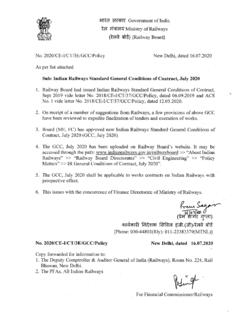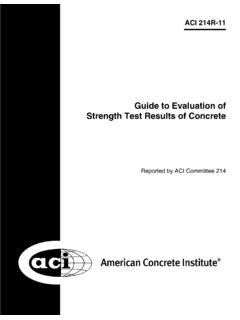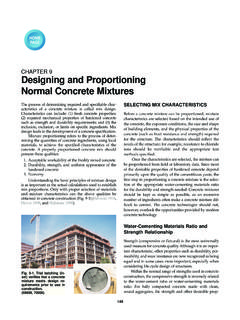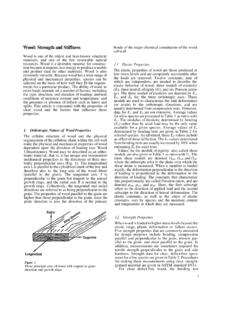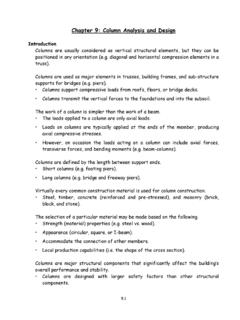Transcription of COMPRESSIVE STRENGTH OF CONCRETE
1 COMPRESSIVE STRENGTH OF CONCRETE1. ObjectiveThe COMPRESSIVE STRENGTH of CONCRETE is given in terms of the characteristic COMPRESSIVE STRENGTH of150 mm size cubes tested at 28 days (fck)- as per Indian Standards (ACI standards use cylinder ofdiameter 150 mm and height 300 mm). The characteristic STRENGTH is defined as the STRENGTH of theconcrete below which not more than 5% of the test results are expected to fall. Characteristic STRENGTH of CONCRETE is the STRENGTH of CONCRETE specimens casted and tested as per givencode of practice and cured for a period of 28 days; 95% of tested cubes should not have a value lessthan this 1: Normal Distribution curve on test specimens for determining COMPRESSIVE strength2.
2 Apparatus RequiredFig. 2: Compression Testing MachineThe testing machine may be of any reliable type, of sufficient capacity for thetests and capable of applying the load at the specified rate. The permissibleerror shall be not greater than 2 percent of the maximum 3: Moulds/ Cubes for TestingThe mould shall be of 150 mm size conforming to IS: ReferenceIS 516:1959 Methods of Tests for STRENGTH of CONCRETE (Eighteenth revision). Reaffirmed- May 20134. Procedure1. All materials shall be brought to room temperature, preferably 27 3 oC before commencing Samples of aggregates for each batch of CONCRETE shall be of the desired grading and shall be in anair-dried condition.
3 The cement samples, on arrival at the laboratory, shall be thoroughly mixeddry either by hand or in a suitable mixer in such a manner as to ensure the greatest possibleblending and uniformity in the material. Care being taken to prevent intrusion of foreign The proportions of the materials, including water, in CONCRETE mixes used for determining thesuitability of the materials available, shall be similar in all respects to those to be employed in The quantities of cement, each size of aggregate, and water for each batch shall be determined byweight, to an accuracy of percent of the total weight of the The CONCRETE shall be mixed by hand, or preferably, in a laboratory batch mixer, in such a manneras to avoid loss of water or other materials.
4 Each batch of CONCRETE shall be of such a size as toleave about 10 percent excess after moulding the desired number of test Each batch of CONCRETE shall be tested for consistency immediately after mixing, by one of themethods described in IS:1199-1959. Provided that care is taken to ensure that no water or othermaterial is lost, the CONCRETE used for the consistency tests may be remixed with the remainder ofbatch before making the test specimens. The period of re-mixing shall be as short as possible yetsufficient to produce a homogeneous Test specimens cubical in shape shall be 15 15 15 cm. If the largest nominal size of theaggregate does not exceed 2 cm, 10 cm cubes may be used as an alternative.
5 Cylindrical testspecimens shall have a length equal to twice the diameter. They shall be 15 cm in diameter and 30cm long. Smaller test specimens shall have a ratio of diameter of specimen to maximum size ofaggregate of not less than 3 to 1, except that the diameter of the specimen shall be not less than7 5 cm for mixtures containing aggregate more than 5 percent of which is retained on IS The test specimens shall be made as soon as practicable after mixing, and in such a way as toproduce full compaction of the CONCRETE with neither segregation nor excessive laitance. Theconcrete shall be filled into the mould in layers approximately 5 cm deep. In placing each scoopfulof CONCRETE , the scoop shall he moved around the top edge of the mould as the CONCRETE slidesfrom it, in order to ensure a symmetrical distribution of the CONCRETE within the mould.
6 Each layershall be compacted either by hand or by The test specimens shall be stored in a place, free from vibration, in moist air of at least 90 percentrelative humidity and at a temperature of 27 2 C for 24 hours hour from the time ofaddition of water to the dry The ends of the specimen shall be capped before testing. The material used for the capping shallbe such that its COMPRESSIVE STRENGTH is greater than that of the CONCRETE in the core. Caps shall bemade as thin as practicable and shall not flow or fracture before the CONCRETE fails when thespecimen is tested. The capped surfaces shall be at right angles to the axis of the specimen andshall not depart from a plane by more than 0 05 The bearing surfaces of the testing machine shall be wiped clean and any loose sand or othermaterial removed from the surfaces of the specimen which are to be in contact with thecompression In the case of cubes, the specimen shall be placed in the machine in such a manner that the loadshall be applied to opposite sides of the cubes as cast, that is, not to the top and The axis of the specimen shall be carefully aligned with the centre of thrust of the sphericallyseated platen.
7 No packing shall be used between the faces of the test specimen and the steelplaten of the testing The load shall be applied without shock and increased continuously at a rate of approximately 140kg/sq cm/min until the resistance of the specimen to the increasing load breaks down and nogreater load can be The maximum load applied to the specimen shall then be recorded and the appearance of theconcrete and any unusual features in the type of failure shall be Observation And Recording< (mm2)Load(N)CompressiveStrength(N/mm2) (MPa)13days2347days56728days89 Table 1 : Recordings during COMPRESSIVE Test on Concrete6. CalculationThe measured COMPRESSIVE STRENGTH of the cubes shall be calculated by dividing the maximum loadapplied to the cubes during the test by the cross-sectional area, calculated from the mean dimensions ofthe section and shall be expressed to the nearest N/mm2.
8 In determining the COMPRESSIVE STRENGTH , donot consider specimens that are manifestly faulty, or that give strengths differing by more than 10 percentfrom the average value of all the test The average 3 Days COMPRESSIVE STRENGTH of given cement sample is found to be ..2. The average 7 Days COMPRESSIVE STRENGTH of given cement sample is found to be ..3. The average 28 Days COMPRESSIVE STRENGTH of given cement sample is found to be ..7. GraphDraw graph between Characteristics COMPRESSIVE STRENGTH of CONCRETE versus Time (Days).Fig. 4 : Plot of Characteristics COMPRESSIVE STRENGTH of CONCRETE versus Time (Days). COMPRESSIVE STRENGTH of CONCRETE








